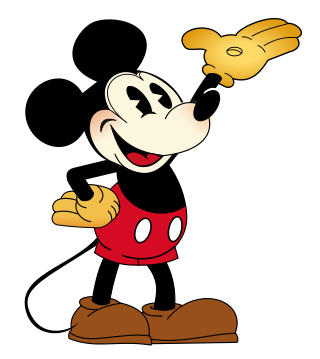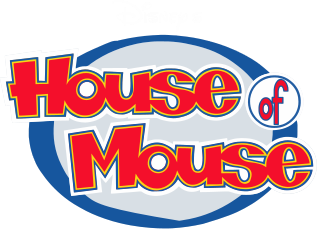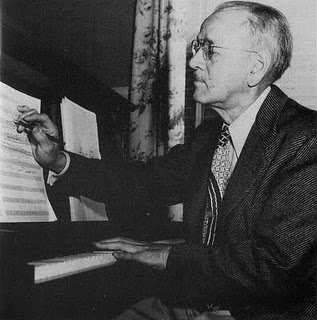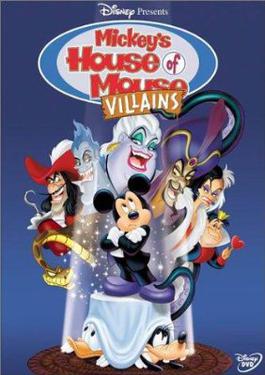
Mickey Mouse is an American cartoon character co-created in 1928 by Walt Disney and Ub Iwerks. The longtime icon and mascot of the Walt Disney Company, Mickey is an anthropomorphic mouse who typically wears red shorts, large shoes, and white gloves.

Goofy is an American cartoon character created by the Walt Disney Company. He is a tall, anthropomorphic dog who typically wears a turtle neck and vest, with pants, shoes, white gloves, and a tall hat originally designed as a rumpled fedora. Goofy is a close friend of Mickey Mouse and Donald Duck, and is Max Goof's father. He is normally characterized as hopelessly clumsy and dim-witted, yet this interpretation is not always definitive; occasionally, Goofy is shown as intuitive and clever, albeit in his own unique, eccentric way.

Disney's House of Mouse is an American animated television series produced by Walt Disney Television Animation that originally aired on ABC and Toon Disney from January 13, 2001, to October 24, 2003, with 52 episodes and 22 newly produced cartoon shorts made for the series. The show focuses on Mickey Mouse and his friends running a cartoon theater dinner club in the fictional setting of ToonTown, catering to many characters from Disney cartoons and animated movies while showcasing a variety of their cartoon shorts. The series is named after a common nickname or epithet for the Walt Disney Company.

Minerva "Minnie" Mouse is an American cartoon character created by the Walt Disney Company. As the longtime sweetheart of Mickey Mouse, she is an anthropomorphic mouse with white gloves, a red or pink bow, blue polka-dotted dress, white bloomers and low-heeled shoes occasionally with ribbons on them. The Mickey Mouse comic strip story "The Gleam" by Merrill De Maris and Floyd Gottfredson first gave her full name as Minerva Mouse, although this is seldom used.

Carl William Stalling was an American composer, voice actor and arranger for music in animated films. He is most closely associated with the Looney Tunes and Merrie Melodies shorts produced by Warner Bros., where he averaged one complete score each week, for 22 years.

The golden age of American animation was a period in the history of U.S. animation that began with the popularization of sound synchronized cartoons in 1928 and gradually ended in the 1960s when theatrical animated shorts started to lose popularity to the newer medium of television. Animated media from after the golden age, especially on television, were produced on cheaper budgets and with more limited techniques between the 1960s and 1980s.

Bosko is an animated cartoon character created by animators Hugh Harman and Rudolf Ising. Bosko was the first recurring character in Leon Schlesinger's cartoon series and was the star of thirty-nine Looney Tunes shorts released by Warner Bros. He was voiced by Carman Maxwell, Johnny Murray, and Billie "Buckwheat" Thomas during the 1920s and 1930s and once by Don Messick during the 1990s.
While the history of animation began much earlier, this article is concerned with the development of the medium after the emergence of celluloid film in 1888, as produced for theatrical screenings, television and (non-interactive) home video.

Foxy is an animated cartoon character featured in the first three animated shorts in the Merrie Melodies series, all distributed by Warner Bros. in 1931. He was the creation of animator Rudolf Ising, who had worked for Walt Disney in the 1920s.

Runaway Brain is a 1995 American animated comedy horror short film produced by Walt Disney Feature Animation. Featuring Mickey Mouse and Minnie Mouse, the short centers on Mickey attempting to earn money to pay for an anniversary gift for Minnie. He responds to an advertisement to work for Doctor Frankenollie, only to find out that he is looking for a donor to switch brains with the monster he created. Featuring animation by animator Andreas Deja, it was first released in 1995 attached to North American theatrical showings of A Kid in King Arthur's Court and in 1996 attached to international theatrical showings of A Goofy Movie. It would be the final original Mickey Mouse theatrical animated short until Get a Horse! in 2013.
Dave Wasson is an American animator, storyboard artist, director, producer, writer, and voice actor. Wasson created the Cartoon Network original series Time Squad, before going on to develop Star vs. the Forces of Evil as director, writer, and executive producer. He also served as director and writer of the series Mickey Mouse Shorts, supervising director of Making Fiends, and executive producer and director of the series The Buzz on Maggie. He is also the author and illustrator of the children's book The Big Ideas of Buster Bickles. Wasson is currently developer and executive producer of The Cuphead Show! for Netflix.

Disney Television Animation (DTVA) is an American animation studio that serves as the television animation production arm of Disney Branded Television, a division of Disney General Entertainment Content, which is a division of Disney Entertainment. The studio was originally established in 1984, by Gary Krisel during the reorganization and subsequent re-incorporation of Disney following the arrival of then CEO Michael Eisner that year.

Mickey Mouse Clubhouse is an American animated interactive television series for preschoolers. Produced by Disney Television Animation, the series was created by Disney veteran Bobs Gannaway. The series originally aired 125 episodes from May 5, 2006, to November 6, 2016, on the Disney Channel's preschool block, Playhouse Disney, making it the longest-running original series to air on the block. It received generally positive reviews from critics.

Mickey's House of Villains is a 2002 American direct-to-video animated comedy-horror film produced by Walt Disney Television Animation. It is based on the animated television series House of Mouse and serves as a stand-alone sequel to the direct-to-video animated film Mickey's Magical Christmas: Snowed in at the House of Mouse, starring Mickey Mouse, Donald Duck, Minnie Mouse, Goofy, Daisy Duck, and Disney Villains that appeared in past Disney productions. It was released on both VHS and DVD by Walt Disney Home Entertainment on September 3, 2002.
Paul Rudish is an American animator, storyboard artist, writer, and voice actor, originally known for his art, writing, and design work at Cartoon Network Studios on series created by Genndy Tartakovsky. He went on to co-create the series Sym-Bionic Titan and, in 2013, developed, wrote, storyboarded, executive produced, and directed a revival of Mickey Mouse short cartoons.

Minnie's Bow-Toons is an American animated preschool television series from Disney Television Animation. The series aired from November 14, 2011, to January 22, 2016, on Disney Junior, as a short-form series targeted at very young girls, as well as the spin-off from Mickey Mouse Clubhouse. The series is based on the Mickey Mouse Clubhouse episode "Minnie's Bow-tique". In both the episode and its spin-off, Minnie opens the same boutique from the former - this time with bows and bow-ties.

Get a Horse! is a 2013 American animated comedy short film produced by Walt Disney Animation Studios and directed by Lauren MacMullan. Combining black-and-white hand-drawn animation and color computer animation, the short features the characters of the late 1920s Mickey Mouse cartoons.

Roger Rabbit is a fictional animated anthropomorphic rabbit. The character first appeared in author Gary K. Wolf's 1981 novel, Who Censored Roger Rabbit? In the book, Roger is second banana in a popular comic strip, "Baby Herman". Roger hires private detective Eddie Valiant to investigate why his employers, the DeGreasy Brothers, have reneged on their promise to give Roger his own strip. When Roger is found murdered in his home, Valiant sets out to look for the killer, with the help of Roger's "doppel".

The Cuphead Show! is an animated slapstick comedy television series developed by Dave Wasson for Netflix, based on the 2017 video game Cuphead by Studio MDHR. Chad and Jared Moldenhauer, the creators of Cuphead, serve as executive producers, along with Wasson and CJ Kettler from King Features Syndicate, and Cosmo Segurson serving as co-executive producer.
















